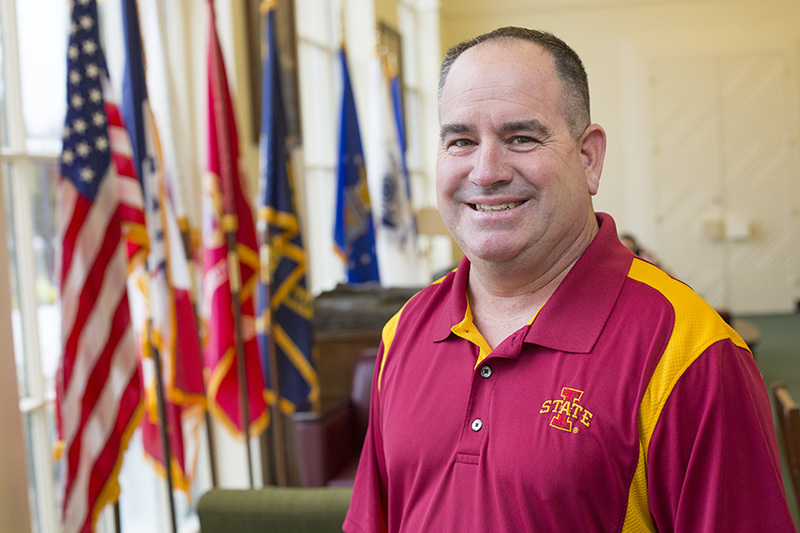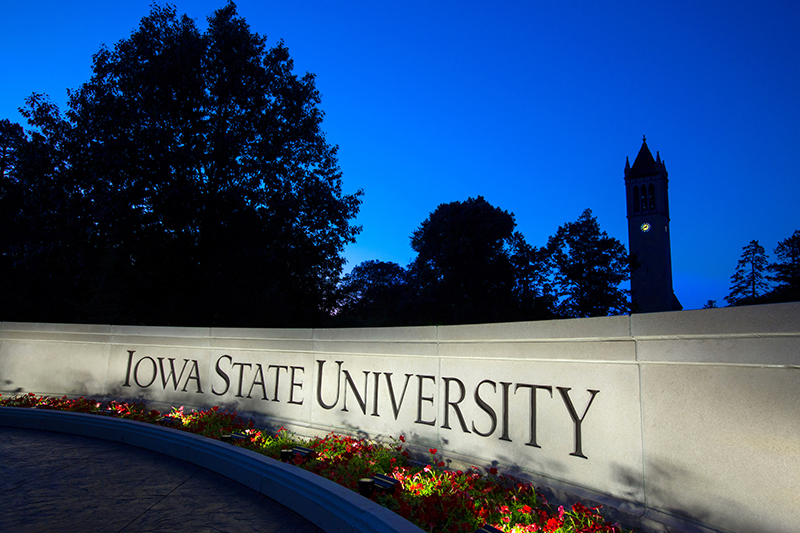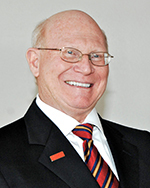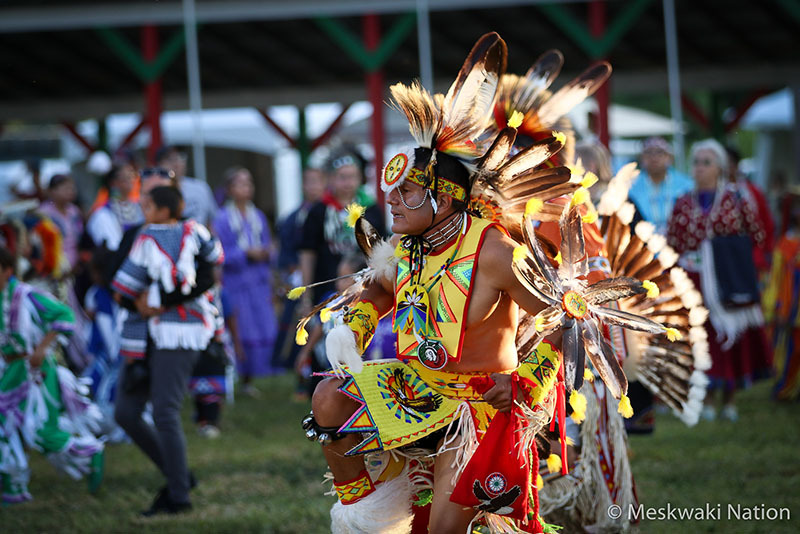A warm, bright spot on a chilly day

Photo by Christopher Gannon.
Chit Lin, a junior in horticulture, watered chrysanthemums and poinsettias in the Horticulture Hall greenhouses earlier this week. Horticulture Club students are gearing up for their annual holiday poinsettia sale later this month; preorders are due Monday, Nov. 13. Retail sale dates are Nov. 29-Dec. 2; check the calendar for locations and hours.
Five questions for a dual-career employee

Ron Sykora. Photo by Christopher Gannon.
The basics
Name: Ron Sykora
Position at ISU: Veterans certification official, office of records and registration
Time at ISU: One year, minus seven months of deployment
Military rank: Lieutenant colonel, Army Reserve
Time in the military: 28 years
One career is usually enough for most faculty and staff to juggle. But Ron Sykora and other military reservists on campus have dedicated themselves to two careers -- one at Iowa State and the other to the United States military. As Veterans Day approaches and Americans honor the sacrifices of those who defend our country, Sykora discusses why -- for him -- two careers are better than one.
You have two careers: one here at Iowa State and one with the Army Reserve. Describe what you do for both.
Here at Iowa State, I'm the lead veterans certification official for all chapters of the GI Bill. We serve veterans and veterans' dependents who are using the GI Bill to help fund their education. We identify who those students are and help facilitate the process to make sure they're on track to make the best use of the GI Bill.
I’ve served in the military since 1989, and I'm currently a lieutenant colonel with the 103rd Sustainment Command (Expeditionary) U.S. Army Reserve, based at Fort Des Moines. My unit is responsible for command and control of sustainment units, which provide the life support systems for troops -- supplies, maintenance and equipment -- within a theater.
You've been with Iowa State just over a year, but your career here had an unusual start.
My job interview was in the morning, and I was on an airplane to Germany that afternoon for 45 days of military duty. I was told that if I'm the right person, the university will wait. While I was in Germany, they offered me the position. When I came back, I was here two months when I got word that the Army was going to activate me to lead a planning cell for a mission in Europe, called Saber Guardian 2017. Two months after that, I was gone. The majority of my time was spent in Hungary, Romania and Bulgaria, with a few weeks of planning in Germany. I was gone for seven months. I left in mid-February and just came back to work at Iowa State on Oct. 2.
What were the specifics of the mission?
Saber Guardian was the largest exercise in Europe this year for U.S. allied and partner forces. There were 21 nations and 40,000 troops involved. The exercise was to show our allied partners and partner nations that we will work with them and work as a deterrent against aggression in Eastern Europe by outside entities. It was partially to show those outside entities the capabilities we have to combine together to provide security.
How did Iowa State handle your absence and your return?
The university hired a temporary employee to handle my workload for about six months. When I came back, the registrar's office welcomed me back with open arms, right back to the same desk, same computer, same everything. Even some of the Post-its I had on the computer were still there. In some cases, it was like I never left. But there were changes to the GI Bill that happened while I was gone, so I have to figure out where we're at and what it means. I was lucky that I wasn't gone for a very long time so I could keep track of what was going on. Iowa State kept my email account active, so if somebody sent me an issue, I could forward it to somebody else who could handle it while I was gone.
You've spent 28 years in various arms of the U.S. military – Navy Reserve, Army National Guard and now the Army Reserve. Why do you continue to serve?
I joined the service because there was this feeling that I owed something to this country. You can wrap it in patriotism, but it was more than that. This country has provided so many opportunities for myself and others, I felt a need to give something back. And there were good education benefits afforded to me. I was able to use those benefits to work toward my degree. There's a sense of belonging in the military. There's a continued sense of being actively involved in an organization whose whole purpose is to defend our way of life and the freedoms we enjoy. I look at it like I get to keep doing this, not that I have to.
Faculty help peers create fair searches, welcoming departments
Six years after its initial grant funding ended, Iowa State's colleges and the senior vice president and provost's office continue to invest in ISU ADVANCE, freeing up a handful of faculty to work part time on recruiting, retaining and promoting women and people of color in faculty posts.
ISU ADVANCE originally is the product of a five-year, $3.3 million 2006 National Science Foundation designed to support female faculty in STEM fields. It still supports two main initiatives: equity advisers and the Department Enhancement Program (DEP), said psychology professor Lisa Larson, faculty fellow in the provost's office who oversees ISU ADVANCE.
The equity adviser team includes a tenured faculty member from each college and the library who train their peers to avoid bias and use best practices in faculty searches. They also serve as advocates for diversity and inclusion within their colleges in various ways, Larson said.
Equity advisers
- Monica Haddad, Design
- Susan Lamont, Agriculture and Life Sciences
- Valentina Salotti, Business
- Eulanda Sanders, Human Sciences
- Hilary Seo, Library
- Sriram Sundararajan, Engineering
- Javier Vela, Liberal Arts and Sciences
- Heather West Greenlee, Veterinary Medicine
DEP facilitators
- Susan Stewart, sociology
- Meifen Wei, psychology
Two Iowa State social science professors work part time on DEP surveys, which are climate assessments of individual academic departments, she said.
Though the goal is removing obstacles to hiring and promoting historically marginalized scholars, ISU ADVANCE's efforts benefit everyone, Larson said.
"That's our fundamental assumption: That we raise everybody up," she said.
Equity advisers
Deans select equity advisers for their colleges, typically a seasoned faculty member. It's important advisers are seen as colleagues because it makes their counsel more influential, said Larson, who worked as an equity adviser before her half-time appointment to the faculty fellow post.
"It's not like somebody coming in from the outside. I'm on your team. I've been in this environment," she said.
Advisers' duties vary, as does the share of the position the college covers -- no more than one-third of their time, Larson said. Providing training for faculty searches is central to the role, guidance that's required for search committee members in some colleges, such as Liberal Arts and Sciences, she said. Equity advisers also conduct training for some administrative searches. For instance, Sriram Sundararajan, equity adviser in Engineering, spoke with the presidential search committee before it selected semifinalists.
Though they collaborate on ideas and approaches, advisers prepare their own materials tailored for their colleges. A big piece of their work is helping search committee members recognize their own implicit biases, which are unavoidable, Larson said.
"We all come from a set of experiences that have led us to this point," she said.
But it's not just about awareness, she said. Using practices that promote inclusion and objectivity help counter bias and improve decision-making in general.
Larson said search committees should resist pressure to move too quickly, avoid valuing specific backgrounds and evaluate candidates with agreed-upon criteria. Using criteria scores to collect assessments from throughout an academic department ensures balanced feedback.
"You'll actually have lots of data that's not about the big mouth in the room that wants to talk all the time," she said. "More voices is better than fewer voices."
Department Enhancement Program
The other major arm of ISU ADVANCE is the DEP climate assessments, which have been conducted in 20 departments so far and two more this fall -- about one-third of Iowa State's academic departments.
A review under the DEP takes a semester to conduct and usually is prompted by an upcoming accreditation or the installation of a new department chair, Larson said. Departments are selected for a review in consultation with college deans, she said. For the second straight year, four departments will be surveyed. This fall, the library and electrical and computer engineering are under review.
A faculty facilitator meets with the department chair and groups of professors by rank, asking how department policies, structures and procedures affect them. If something comes up at least three times, it's likely worth consideration, Larson said.
"Sometimes that's a positive thing, sometimes it's a thing they're hoping could be different," she said.
The facilitator writes a report based on the interviews, which is distributed throughout the department. The faculty propose solutions to issues, such as adjusting meeting times to accommodate parental responsibilities or making promotion requirements clearer.
Follow-up studies showed an average of more than 18 action items were identified, with more than three-quarters of them implemented. That's an impressive rate, Larson said.
"As a social scientist, I can't get anybody to do that well as an individual client," she said.
Addressing departmental culture concerns of the entire faculty is a more holistic, less limiting way of ensuring a welcoming environment for women and people of color, Larson said.
"If we do any of these implementations, yeah, it should help that African-American scholar, right?" Larson said. "She wants to know what is clearly the criteria for promotion and tenure. She doesn't want it to be some kind of hidden agenda."
Iconic campus photos available for sale

This night shot of the university wall and campanile is in a public gallery of campus images now available for purchase. Photo by Christopher Gannon.
Plenty has been written about Iowa State's spectacular campus, and in his three years on the job, university photographer Christopher Gannon has worked to capture some of that beauty. A new photo system in the office of university relations and contract with an off-campus photo finisher now make it possible for members of the public to purchase prints of many iconic images.
"We've had requests from alumni and friends for high-quality, professional campus images, so we decided to make this service available," Gannon said. Most universities and colleges sell images this way in response to demand, he added.
Two years ago, to better serve the campus community, university relations contracted with PhotoShelter for a digital photo system that has image sharing and archiving functions lacking in the office's previous in-house server. Gannon said currently there are about 140 campus images in an online public gallery, with more added every month. Locations include central campus, Reiman Gardens, Jack Trice Stadium and Lake LaVerne. The gallery's key-word search function works by building or season, for example, "campanile" or "spring."
Take a look
Campus images gallery in PhotoShelter
What are my options?
Shoppers may choose from two color products: prints and canvas gallery wraps -- a canvas print wrapped over a wood frame. They're produced and shipped by a vendor in suburban St. Paul.
Color prints may be purchased in seven sizes -- from 4 inches by 6 inches to 30 inches by 40 inches -- and two finishes, glossy or luster. Prices range from $4 to $250. Canvas gallery wraps range in size from 8 inches by 10 inches to 40 inches by 60 inches and in price from $100 to $650. All products ship directly to the buyer.
Gannon said the print revenue will be shared. The photo finisher, White House Custom Color, receives the cost of making the print or wrap, PhotoShelter receives a commission and university relations will use the rest to recoup part of its annual contract fee with PhotoShelter.
How does it work?
Buying prints or canvas wraps is a self-service process. To make a purchase, shoppers simply click on an image (full size, not thumbnail size) in the gallery.
- A shopping cart icon appears in the lower right corner of the window as one of the options.
- Click on the cart icon. A "buy this image" window leads to an options window. Select the quantities, sizes and finishes desired.
- Shoppers may check out as a guest or set up an account.
- Online payment is made via PayPal, where either an account or a debit/credit card are accepted.
Digital options
All images in the gallery also are available in a free, low-resolution (1,200 pixels wide) digital download, suitable for Instagram use, Twitter header or as a small screen saver.
Full-resolution digital downloads, for use in professional products such as posters, pop-up displays or wall decals, are available only to university units for a $25 fee. To request a full-res digital image, email Gannon.
"The intended spirit of these high-res downloads is that colleges or departments will use them to promote their unit," Gannon said.
Colletti named interim endowed dean of Agriculture and Life Sciences
Joe Colletti, senior associate dean of the College of Agriculture and Life Sciences and associate director of the Iowa Agriculture and Home Economics Experiment Station, has been named the college's interim endowed dean, effective Nov. 20. He also will serve as interim director of the experiment station.
Colletti takes over for Wendy Wintersteen, who becomes Iowa State's 16th president on the same date.

Colletti
"Joe is familiar with every aspect of the college's mission and operations, and its service to the people of Iowa," President-select Wintersteen said. "He will maintain the strong momentum in our academic and research programs, and work with stakeholders both on and off campus to share our expertise with the world."
In making the appointment, senior vice president and provost Jonathan Wickert noted that Colletti's experience on campus will ensure a smooth transition to the next permanent dean.
"Joe Colletti has a well-deserved reputation for collegiality and service that will help the college and university move forward during a critical time of record enrollments and budget challenges," Wickert said. "I am confident he will do very well in the interim role."
Colletti, who joined Iowa State's forestry faculty in 1978, earned a bachelor's degree in forestry from Humboldt State University, Arcata, California, and master's and Ph.D. degrees in forest economics from the University of Wisconsin, Madison. He was appointed senior associate dean in 2006 after serving as interim chair of the natural resource ecology and management department in 2004-05.
In his current positions, Colletti oversees budgets, resources and personnel for the college and experiment station. He also facilitates bioeconomy-related research, including development of the BioCentury Research Farm.
"It has been a great privilege to watch the college grow in both stature and impact over the last 40 years, and I am humbled by the opportunity to lead the college during the interim period," Colletti said.
Iowa State will launch a national search for the next permanent dean in the coming weeks.
Seeing Native America

Photo courtesy of Meskwaki Nation.
Dancers from Meskwaki Nation, based in Tama, Iowa, will perform Monday, Nov. 13, in the Memorial Union Great Hall. The 6 p.m. performance precedes a 7 p.m. lecture by Matika Wilbur, a photographer and social documentarian from the Swinomish and Tulalip tribes in the Pacific Northwest. Wilbur's talk, "Changing the Way We See Native America," highlights her three-year "Project 562" to photograph more than 560 tribes throughout America. The events are part of Indigenous Heritage Month programming by the lectures committee.
